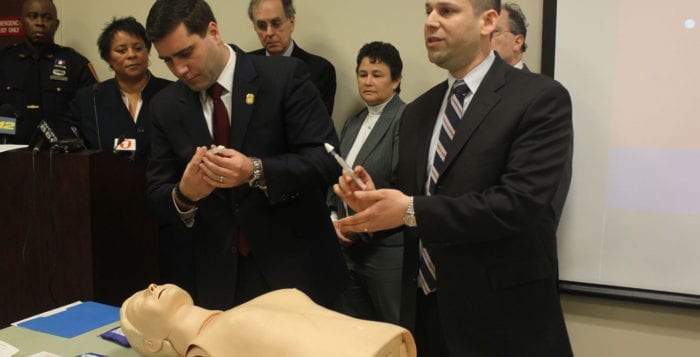Police shine light on the ugly truths of drug abuse

Suffolk County Police Commissioner Tim Sini updated the community last week on the success of the department’s Ugly Truth program, a county-wide initiative designed to curb opioid use through community seminars that educate parents and teens, provide treatment options to help those in need of recovery, and shine a graphic light on what these drugs do to those who take them.
The commissioner and local officials took to West Islip Public Library Jan. 25 to champion the department’s Ugly Truth program.
“It’s very important that we recognize the problem, talk about the problem clearly and intelligently, and that we provide people with the tools necessary to get their lives back on track,” Sini said at the press conference that addressed what’s being done by the police to combat the county’s rising heroin and opiates problem.
Suffolk residents who attend the seminars also learn how to administer Narcan, the life-saving drug that reverses the effects of an overdose and helped save well over 200 lives in 2016.
“It’s very important that we recognize the problem, talk about the problem clearly and intelligently, and that we provide people with the tools necessary to get their lives back on track.”
— Tim Sini
Sini said the epidemic has climbed in the past year, with upwards of 346 fatal opioid-related overdoses in 2016 as opposed to more than 270 fatal opioid-related overdoses in 2015.
“We need to be invested in solving this problem…there’s no silver bullet here, we need to fight it on all fronts: on the law enforcement front, on the prevention front, on the treatment front, and recovery front,” Sini said.
Since the Ugly Truth program launched in March 2015, with an emergency medical services unit and the medical examiner’s office, 41 forums have been held with a total 3,500 participants. Nearly 700 attendees were between the ages 14 and 17; more than 3,000 have been trained to administer Narcan and 2,400 Narcan kits have been distributed.
A segment of the forum, “Operation: Medicine Cabinet,” teaches parents to make sure prescription drugs are properly disposed of to prevent their kids from rummaging through and finding anything that might be harmful. People in recovery who’ve experienced substance abuse disorders are also brought in to talk about how their addiction has affected their lives and those around them, and resources geared toward combatting addiction, including the Suffolk County Substance Abuse Hotline number, are made available.
The Suffolk County Police Department has also partnered with the Long Island Council on Alcoholism and Drug Dependence and other organizations to help overdose victims get treatment.
After an overdose, the department gives the victim’s contact information to LICADD and other organizations, which then reach out to the victim about recovery options. In 2016, SCPD provided LICADD with information on 221 overdose victims; 59 of those victims were successfully contacted, and 26 of them were involved in treatment. According to officials these statistics are improving every year.
“If we don’t get personal, families suffer personally and that’s what the Ugly Truth is about,” SCPD Deputy Commissioner Risco Mention-Lewis said. “It’s to be thought of as a personal relationship with members of the bureau, communities, parents and families to say ‘we know you’re suffering, you may not even know what to look for, but we can help you stop this as soon as possible.’”
Officials said nothing hits attendees — especially young ones — harder than when medical examiners and medical experts from the Suffolk County Department of Health Services show slides of some of the devastating physical effects of substance abuse. These graphic images include a side-by-side comparison of a normal heart to a yellowing deteriorated heart and frothing from the mouth and nose as a result of leaky blood vessels in the lung, both caused by opioid use.
“While these pictures are not for shock value, we are trying to scare them [teenagers] a little bit and show them some of the things we actually see in the medical examiner’s office,” Suffolk County Chief Medical Examiner Dr. Michael Caplan said. “I also want kids and families to know…it’s not just about the overdose; there are multiple other complications, diseases, and infections that can also be complications of addiction.”
“If we don’t get personal, families suffer personally and that’s what the Ugly Truth is about.”
— Risco Mention-Lewis
Sini and EMS Officer Jason Byron gave a brief demonstration of Narcan training that Ugly Truth program attendees receive. While the commissioner was quick to point out that Narcan doesn’t cure drug addiction and won’t wipe out the epidemic, he said it’s a step in the right direction.
“Each life we save with Narcan is a potential story of recovery,” he said. “It’s to be administered to the overdosing person as quickly as possible so they’re still alive when first responders arrive. If you administer Narcan, you must call 911 once the person is revived.”
Dr. Scott Coyne, chief police surgeon in the SCPD, has been instrumental in implementing Narcan in the department. He said he’s pleased with how successful it’s been so far.
“There’s just a dramatic number of people that are walking around now that would never have been walking around [without Narcan],” Coyne said. “Unfortunately there is a need for this. It’s a two-edged sword. It’s a great program, but it also points out the extent of the problem.”
The commissioner expressed optimism the prevention work of the program has been effective. Even though the county saw a record amount of deaths brought on by opioids in 2016, the average age of those overdosing is higher than it’s been in the past. He said it’s suggestive that the department’s awareness is getting through to young people.
“While the numbers don’t seem to be going down, there is that one silver lining,” Sini said. “This is a long-term investment that we need to be making. We’ve made a lot of progress on the treatment front. The next frontier has to be prevention and recovery. There has been a complete acceptance now that this is an epidemic that affects all communities, all races, and all demographics.”






